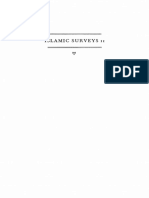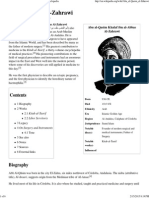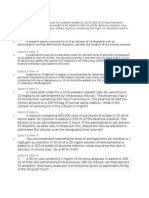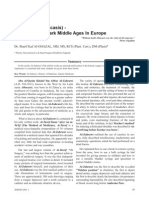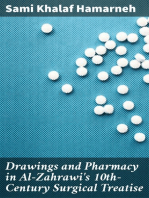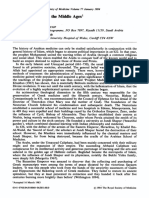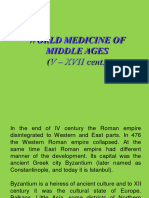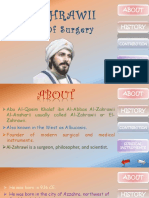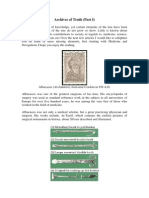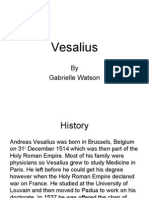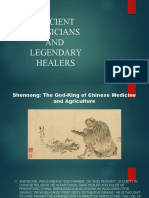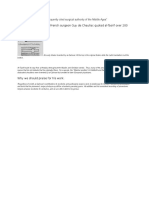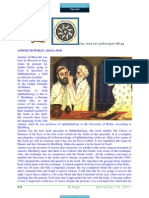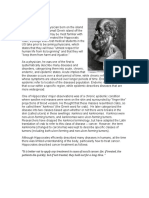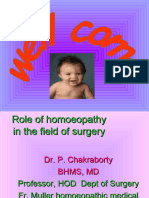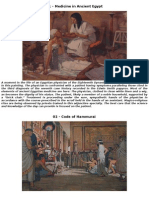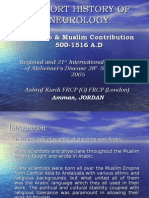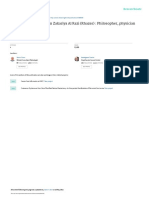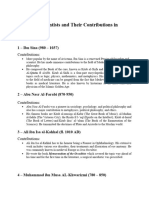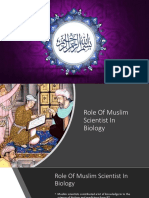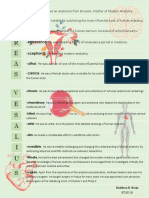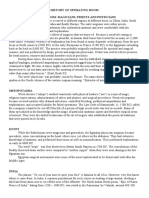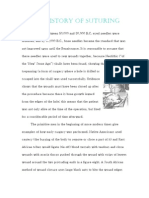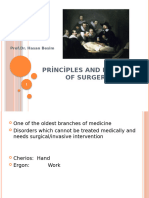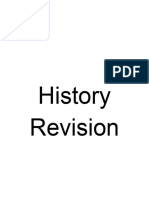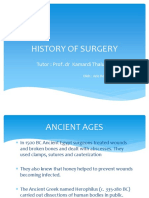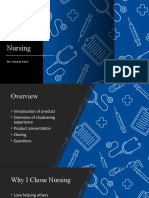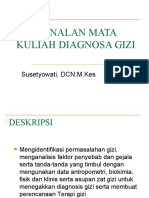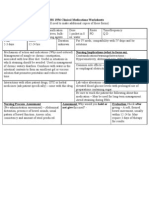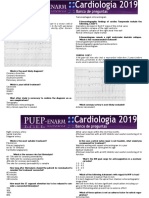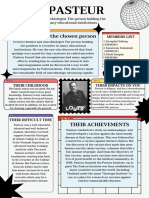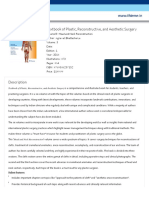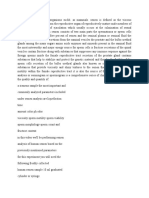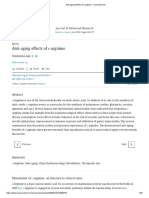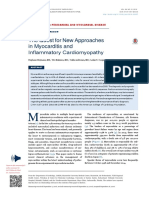Abu Al
Abu Al
Uploaded by
Mariam AliCopyright:
Available Formats
Abu Al
Abu Al
Uploaded by
Mariam AliOriginal Title
Copyright
Available Formats
Share this document
Did you find this document useful?
Is this content inappropriate?
Copyright:
Available Formats
Abu Al
Abu Al
Uploaded by
Mariam AliCopyright:
Available Formats
Abu al-Qasim Khalaf ibn al-Abbas Al-Zahrawi (9361013), (Arabic: )also known in the West as Abulcasis, was an Arab
an Arab physician who lived in AlAndalus. He is considered the greatest medieval surgeon to have appeared from the Islamic World, and has been described by some as the father of modern surgery.[1] His greatest contribution to medicine is the Kitab al-Tasrif, a thirty-volume encyclopedia of medical practices.[2] His pioneering contributions to the field of surgical procedures and instruments had an enormous impact in the East and West well into the modern period, where some of his discoveries are still applied in medicine to this day.[3] He was the first physician to describe an ectopic pregnancy, and the first physician to identify the hereditary nature of haemophilia.[3] Biography Ab Al-Qsim was born in the city of El-Zahra, six miles northwest of Crdoba, Andalusia. He was descended from the Ansar Arab tribe who migrated from Hejaz modern day west Saudi Arabia[citation needed] and settled earlier in Spain. He lived most of his life in Crdoba. It is also where he studied, taught and practiced medicine and surgery until shortly before his death in about 1013, two years after the sacking of El-Zahra. Few details remain regarding his life, aside from his published work, due to the destruction of El-Zahra during later Castillian-Andalusian conflicts. His name first appears in the writings of Abu Muhammad bin Hazm (993 1064), who listed him among the greatest physicians of Moorish Spain. But we have the first detailed biography of al-Zahraw from al-umayd's Jadhwat al-Muqtabis (On Andalusian Savants), completed six decades after al-Zahraw's death. He was a contemporary of Andalusian chemists such as Ibn al-Wafid, Maslamah Ibn Ahmad al-Majriti and Artephius. Works Ab al-Qsim was a court physician to the Andalusian caliph Al-Hakam II. He devoted his entire life and genius to the advancement of medicine as a whole and surgery in particular. His best work was the Kitab al-Tasrif, discussed below. Ab al-Qsim specialized in curing disease by cauterization. He invented several devices used during surgery, for purposes such as inspection of the interior of the urethra, applying and removing foreign bodies from the throat, inspection of the ear, etc. He is also credited to be the first to describe ectopic pregnancy in 963, in those days a fatal affliction.[citation needed] Kitab al-Tasrif Main article: Al-Tasrif Ab al-Qsim's thirty-chapter medical treatise, Kitab al-Tasrif, completed in the year 1000, covered a broad range of medical topics, including dentistry and childbirth, which contained data that had accumulated during a career that spanned almost 50 years of training, teaching and practice. In it he also wrote of the importance of a positive doctor-patient relationship and wrote affectionately of his students, whom he referred to as "my children". He also emphasized the importance of treating patients irrespective of their social status. He
encouraged the close observation of individual cases in order to make the most accurate diagnosis and the best possible treatment. Al-Tasrif was later translated into Latin by Gerard of Cremona in the 12th century, and illustrated. For perhaps five centuries during the European Middle Ages, it was the primary source for European medical knowledge, and served as a reference for doctors and surgeons. Not always properly credited, Ab Al-Qsim's al-Tasrif described both what would later became known as "Kocher's method" for treating a dislocated shoulder and "Walcher position" in obstetrics. Al-Tasrif described how to ligature blood vessels almost 600 years before Ambroise Par, and was the first recorded book to document several dental devices and explain the hereditary nature of haemophilia.[citation needed] He was also the first to describe a surgical procedure for ligating the temporal artery for migraine, also almost 600 years before Pare recorded that he had ligated his own temporal artery for headache that conforms to current descriptions of migraine.[citation needed] Ab al-Qsim was therefore the first to describe the migraine surgery procedure that is enjoying a revival in the 21st century, spearheaded by Elliot Shevel a South African surgeon. Ab al-Qsim also described the use of forceps in vaginal deliveries.[4] He introduced over 200 surgical instruments.[5] Many of these instruments were never used before by any previous surgeons. Hamidan, for example, listed at least twenty six innovative surgical instruments that Abulcasis introduced.[citation needed] His use of catgut for internal stitching is still practised in modern surgery. The catgut appears to be the only natural substance capable of dissolving and is acceptable by the body. Ab alQsim also invented the forceps for extracting a dead fetus, as illustrated in the Al-Tasrif.[6] Liber Servitoris In pharmacy and pharmacology, Ab al-Qsim al-Zahraw pioneered the preparation of medicines by sublimation and distillation. His Liber Servitoris is of particular interest, as it provides the reader with recipes and explains how to prepare the "simples" from which were compounded the complex drugs then generally used.[7][8] Reception In the 14th century, the French surgeon Guy de Chauliac quoted al-Tasrif over 200 times. Pietro Argallata (d. 1453) described Ab al-Qsim as "without doubt the chief of all surgeons". Ab al-Qsim's influence continued for at least five centuries, extending into the Renaissance, evidenced by al-Tasrif's frequent reference by French surgeon Jacques Delechamps (15131588).[citation needed] The street in Crdoba where he lived is named in his honor as "Calle Albucasis". On this street he lived in house no. 6, which is preserved today by the Spanish Tourist Board with a bronze plaque (awarded in January 1977) which reads: "This was the house where AbulQasim lived."
You might also like
- Kitab Al TasrifDocument6 pagesKitab Al TasrifMuhammad Talha Javed Siddiqui100% (3)
- Charalambos Panayiotou Charalambous - The Shoulder Made Easy-Springer International Publishing (2019) PDFDocument558 pagesCharalambos Panayiotou Charalambous - The Shoulder Made Easy-Springer International Publishing (2019) PDFField Jd100% (1)
- Ullmann 1997 - Islamic MedicineDocument158 pagesUllmann 1997 - Islamic MedicineSergey Minov100% (1)
- Ndebreleasedquestions 2019 1 PDFDocument383 pagesNdebreleasedquestions 2019 1 PDFManish JunejaNo ratings yet
- Abu Qasim Khalaf Ibn Al Abbas Al ZahrawiDocument6 pagesAbu Qasim Khalaf Ibn Al Abbas Al ZahrawiMichele Jasmine100% (1)
- Andreas Vesalius PDFDocument9 pagesAndreas Vesalius PDFmisanthropoNo ratings yet
- Muslim Contributions To ScienceDocument11 pagesMuslim Contributions To Scienceisunny_1No ratings yet
- Introduction To SurgeryDocument43 pagesIntroduction To Surgerylexscribis100% (2)
- A Short History of Transfusion MedicineDocument14 pagesA Short History of Transfusion MedicinePatriciaNo ratings yet
- Homework 8Document2 pagesHomework 8Kitsum Li0% (1)
- 1 Al ZahrawiDocument6 pages1 Al ZahrawiAL-Khawaldeh Hamza0% (1)
- Al-Zahrawi AbulcasisDocument2 pagesAl-Zahrawi Abulcasissd.ehtesham100% (2)
- Drawings and Pharmacy in Al-Zahrawi's 10th-Century Surgical TreatiseFrom EverandDrawings and Pharmacy in Al-Zahrawi's 10th-Century Surgical TreatiseNo ratings yet
- Islamic MedicineDocument3 pagesIslamic Medicinejamaluddinahmed195No ratings yet
- Some of Arab and Muslim Physicians Achievements Attributed To Western PhysiciansDocument10 pagesSome of Arab and Muslim Physicians Achievements Attributed To Western PhysiciansQurratu QolbiNo ratings yet
- Islam Zahra Wi Was HahDocument12 pagesIslam Zahra Wi Was HahKing AlexNo ratings yet
- Maristan (Hospitals) in Medieval SpainDocument15 pagesMaristan (Hospitals) in Medieval SpainOsama Shoaib AligNo ratings yet
- Artigo Salerno 4Document6 pagesArtigo Salerno 4Henrique Luiz WeberNo ratings yet
- World Medicine Of Middle Ages: (V - ХVІІ cent.)Document84 pagesWorld Medicine Of Middle Ages: (V - ХVІІ cent.)Daly DaliaNo ratings yet
- Abu Al Qasim Al Zahrawi (Albucasis) : Pioneer of Modern SurgeryDocument3 pagesAbu Al Qasim Al Zahrawi (Albucasis) : Pioneer of Modern SurgeryCuenta LanceNo ratings yet
- Al-Zahrawii (Group 4)Document8 pagesAl-Zahrawii (Group 4)Hannah AinnsvheNo ratings yet
- Elizabethan World ViewDocument5 pagesElizabethan World ViewFredNo ratings yet
- Archives of Truth1Document3 pagesArchives of Truth1api-19490448No ratings yet
- GynecomastiaDocument6 pagesGynecomastiaCarder heroNo ratings yet
- Golden Age of Islamic MedicineDocument26 pagesGolden Age of Islamic MedicineJoko RinantoNo ratings yet
- By Gabrielle WatsonDocument7 pagesBy Gabrielle Watsonapi-17866851No ratings yet
- Ancient HealersDocument19 pagesAncient HealersBreville SageNo ratings yet
- In The 14th Century, The French Surgeon Guy de Chauliac Quoted Al-Tasrif Over 200 TimesDocument1 pageIn The 14th Century, The French Surgeon Guy de Chauliac Quoted Al-Tasrif Over 200 TimesNg Chia ShenNo ratings yet
- History of AnaesthesiaDocument10 pagesHistory of AnaesthesiaJORGE ALBERTO FIERRO LEYVANo ratings yet
- Oriental BackgroundDocument1 pageOriental BackgroundDafydd HumphreysNo ratings yet
- Savage Smith New Evidence For The Frankish Study of Arabic Medical Texts in The Crusader PeriodDocument14 pagesSavage Smith New Evidence For The Frankish Study of Arabic Medical Texts in The Crusader PeriodAshir BeeranNo ratings yet
- Famous Islamic PhysiciansDocument19 pagesFamous Islamic PhysiciansscparcoNo ratings yet
- CA 1.2 Lesson 1.2 Handout - Readings-1Document7 pagesCA 1.2 Lesson 1.2 Handout - Readings-1KATAYAH GLENNNo ratings yet
- Homeopathy SurgeryDocument84 pagesHomeopathy SurgeryNAIMISH VADOLIYANo ratings yet
- History of MedicineDocument40 pagesHistory of MedicineDr. Rajneesh Kumar Sharma MD Hom100% (4)
- A Short History of NeurologyDocument44 pagesA Short History of Neurologywildguess1No ratings yet
- Abu Bakr Muhammad Ibn Zakariya Al Razi (Rhazes) : Philosopher, Physician and AlchemistDocument4 pagesAbu Bakr Muhammad Ibn Zakariya Al Razi (Rhazes) : Philosopher, Physician and AlchemistShah AnNo ratings yet
- 10 Muslim Scientists and Their Contributions in ScienceDocument3 pages10 Muslim Scientists and Their Contributions in ScienceJann MacNo ratings yet
- Role of Muslim Scientist in BiologyDocument6 pagesRole of Muslim Scientist in Biologytasneem0% (1)
- The Other Renaissance: From Copernicus to Shakespeare: How the Renaissance in Northern Europe Transformed the WorldFrom EverandThe Other Renaissance: From Copernicus to Shakespeare: How the Renaissance in Northern Europe Transformed the WorldNo ratings yet
- Muslim Scientist in BiologyDocument20 pagesMuslim Scientist in BiologytasneemNo ratings yet
- Muslim Scientist in BiologyDocument20 pagesMuslim Scientist in Biologytasneem100% (1)
- Isl ProjectDocument7 pagesIsl ProjectAli AsifNo ratings yet
- Muslims' Contribution To Medicine: Dr. H. Elman Boy, M.Kes FK Umsu 2013Document36 pagesMuslims' Contribution To Medicine: Dr. H. Elman Boy, M.Kes FK Umsu 2013Tia AfelitaNo ratings yet
- Acrostic 1 (Andreas Vesalius)Document1 pageAcrostic 1 (Andreas Vesalius)Kathleen BorjaNo ratings yet
- History of Operating RoomDocument9 pagesHistory of Operating RoomKhrizlynne SoberanoNo ratings yet
- Brown and Yellow The Philippines Presentation - 20240221 - 123052 - 0000Document33 pagesBrown and Yellow The Philippines Presentation - 20240221 - 123052 - 0000Richmond RainierNo ratings yet
- 0 - History of Suturing IDocument5 pages0 - History of Suturing IfaizalmasoodiNo ratings yet
- Principles & History of SurgeryDocument26 pagesPrinciples & History of Surgery20210898No ratings yet
- History of AnatomyDocument9 pagesHistory of AnatomyMitkoNo ratings yet
- 8 History of Medix Cine in The Islamic CivilizationDocument13 pages8 History of Medix Cine in The Islamic CivilizationSanthoshsv 143No ratings yet
- Al Razi Asm-4-305Document3 pagesAl Razi Asm-4-305Aanisah100% (1)
- Abu Bakr Muhammad Ibn Zakariya Al Razi (Rhazes) : Philosopher, Physician and AlchemistDocument4 pagesAbu Bakr Muhammad Ibn Zakariya Al Razi (Rhazes) : Philosopher, Physician and Alchemistmad boyNo ratings yet
- Muslim ScientistsDocument7 pagesMuslim Scientistskaveh.aranianNo ratings yet
- The Abbasid Dynasty Final ScriptDocument5 pagesThe Abbasid Dynasty Final Scriptdswhitham8365No ratings yet
- History RevisionDocument15 pagesHistory RevisionhaidiaNo ratings yet
- Abu L - Ala' Zuhr, The Quack of Al-Andalus: Prof - Dr.Luisa Maria Arvide CambraDocument4 pagesAbu L - Ala' Zuhr, The Quack of Al-Andalus: Prof - Dr.Luisa Maria Arvide CambraRUKIYYA DA MAGANI A MUSULUNCENo ratings yet
- CarranzaDocument2 pagesCarranzaEli KurtiNo ratings yet
- ShahazDocument15 pagesShahazfarooqiyya dawaNo ratings yet
- Islamic Studies On The Muslim PastDocument32 pagesIslamic Studies On The Muslim PastDorian GreyNo ratings yet
- Arie History of SurgeryDocument20 pagesArie History of SurgeryArie RezaNo ratings yet
- Surgery BTR 2.0 Gupta Ji Ro TabarDocument79 pagesSurgery BTR 2.0 Gupta Ji Ro Tabarvigneshlakshmanan42No ratings yet
- Senior Project PresentationDocument25 pagesSenior Project Presentationapi-542121619No ratings yet
- Chapter 139: Urinary Tract Infections Self-Assessment QuestionsDocument4 pagesChapter 139: Urinary Tract Infections Self-Assessment QuestionsTop VidsNo ratings yet
- Pengenalan Mata Kuliah Diagnosa Gizi: Susetyowati, DCN.M.KesDocument38 pagesPengenalan Mata Kuliah Diagnosa Gizi: Susetyowati, DCN.M.Kesshienyoel100% (1)
- Sbas and Emqs For Mrcog IiDocument16 pagesSbas and Emqs For Mrcog Iiasfh hgore100% (1)
- Risky Behaviors of AdolescentsDocument8 pagesRisky Behaviors of AdolescentsMary CaputeroNo ratings yet
- Powell 1973 Dunlop Traction in Supracondylar Fractures of The HumerusDocument3 pagesPowell 1973 Dunlop Traction in Supracondylar Fractures of The HumerusPsychotic GuyNo ratings yet
- Maklumat Vaksinasi: Vaccination DetailsDocument2 pagesMaklumat Vaksinasi: Vaccination DetailsJonathan LeeNo ratings yet
- Hypertension in Thyroid DisordersDocument11 pagesHypertension in Thyroid Disordersaqibmalik1071No ratings yet
- MetamucilDocument1 pageMetamucilSheri490No ratings yet
- Prospectus: Care - AdvantageDocument49 pagesProspectus: Care - AdvantageXen Operation DPHNo ratings yet
- Science: Quarter 2 - Module 1Document20 pagesScience: Quarter 2 - Module 1Kate Batac100% (2)
- Evaluation of Dogs and Cats With Tumors of The Ear Canal: 145 Cases (1978-1992)Document7 pagesEvaluation of Dogs and Cats With Tumors of The Ear Canal: 145 Cases (1978-1992)Flaviu TabaranNo ratings yet
- Protein Binding: Naila Abbasi Assistant Professor Department of PharmacyDocument50 pagesProtein Binding: Naila Abbasi Assistant Professor Department of PharmacyMuhammad MursaleenNo ratings yet
- Template Continued On Page 2Document3 pagesTemplate Continued On Page 2JaneNo ratings yet
- Diseases of The Hair and ScalpDocument7 pagesDiseases of The Hair and Scalprl20No ratings yet
- Clinical Case 1Document31 pagesClinical Case 1reginaNo ratings yet
- Atenolol TenorminDocument3 pagesAtenolol TenorminLIEZEL GRACE VELAYONo ratings yet
- HEAL PresentationDocument36 pagesHEAL PresentationTed BakerNo ratings yet
- PROCESS RECORDING-1 CorectedDocument5 pagesPROCESS RECORDING-1 CorectedPallabi SethNo ratings yet
- (Poster) Louis PasteurDocument1 page(Poster) Louis Pasteurกมลวรรณ อาหาสิเมNo ratings yet
- Textbook of Plastic, Reconstructive, and Aesthetic SurgeryDocument2 pagesTextbook of Plastic, Reconstructive, and Aesthetic SurgeryEVELYN EZEKWENo ratings yet
- Urinalisis Sperma - DR RukmanDocument23 pagesUrinalisis Sperma - DR RukmanKristinaNo ratings yet
- Critical Care NursingDocument13 pagesCritical Care NursingAdrienne LeeNo ratings yet
- Anti-Aging Effects of L-Arginine - ScienceDirectDocument26 pagesAnti-Aging Effects of L-Arginine - ScienceDirectJohayrah DiangcaNo ratings yet
- Prosthetic Rehabilitation Preti PDFDocument233 pagesProsthetic Rehabilitation Preti PDFdiaz2050No ratings yet
- The Quest For New Approaches in Myocarditis and in Ammatory CardiomyopathyDocument18 pagesThe Quest For New Approaches in Myocarditis and in Ammatory Cardiomyopathyrohman cooyNo ratings yet


